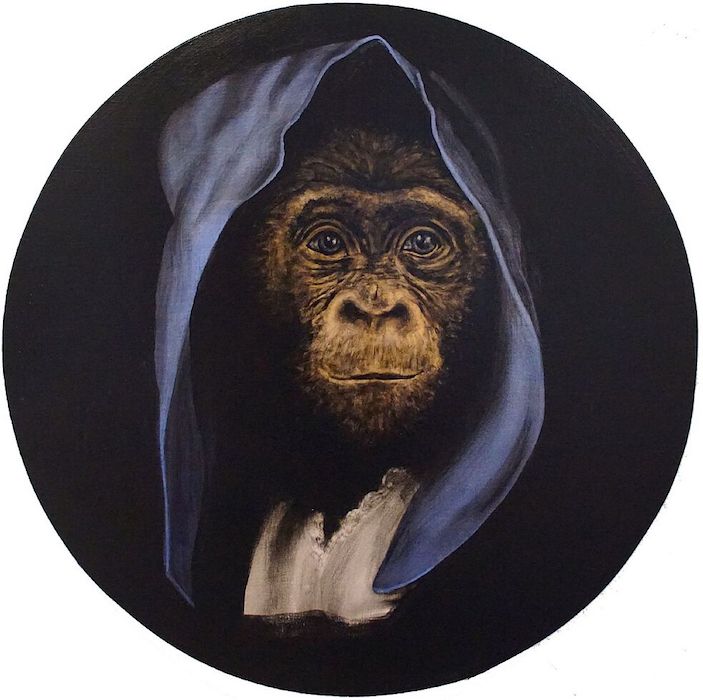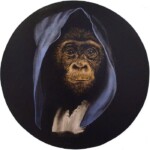Exhibition
in Frankfurt am Main / Germany
- Stefan à Wengen: Le Singe Peintre XXII, 2019, acrylic paint on canvas, Ø 70 cm, Ø 27 1/2 in
- Stefan à Wengen: Le Singe Peintre XXVI, 2019, acrylic paint on canvas, 100 x 80 cm, 39 1/3 x 31 1/2 in
In 1740, Jean Baptiste Siméon Chardin painted a small picture (*) of a monkey – here one of the lemur genus – who, well dressed and with a two-pointed hat on his head, sits in front of the canvas with a brush and a stick, and tried to paint the figure to the right. So the work shows the artist as a monkey, who instead of education only has the ability to reproduce. Or to put it more sincerely: he shows the artist as a monkey who can adapt and wants to be willing to criticize. It is also rumored that Chardin’s image expresses his silent visual criticism of less important colleagues who received a free royal pension in the Louvre before him.
Even the Roman scholar Pliny the Elder, who achieved great renown through his encyclopedic work on natural history, describes the characteristic of the monkey as an animal with human-like features and with a habit of always imitating people, as a kind of caricature of it. The bestiary of the Middle Ages, however, link the monkey with the image of the devil and evil and thereby emphasize its malicious and superficial character.
Despite all of this – or perhaps precisely for these reasons – the monkey found his image motif again and again in painting, both in the old masters and in the modern to the present day. In the so-called Les Singeries from the 17th to 19th centuries, the monkey even took on completely human roles, such as those of the inn goers and their drinking, those of the world travelers or those of the pipe-makers in a smoking salon, seen by painters like Ferdinand van Kessel (1648 – 1696), David Teniers (1610 – 1690) or Sir Edwin Landseer (1802 – 1873). But the most consistent in terms of its context remains Chardin, who shows the monkey in his penchant for mimesis as a mindless imitator, who paints well and sometimes badly, just as luck would have it.
As with Stefan à Wengens “ghost” portraits (2005) and the original “gurus” (2014 – 2017), strictly speaking, and recognizable through collages, he initially creates fakes, which are then turned into originals again through their implementation in painting with their guaranteed claim to truth. In the “Le Singe Peintre” series, however, he used portrait paintings from, among others, Frans Hals, Rembrandt, van Eyck or Bruyn, in which I swap the heads and hands with those of a primate. It is a game similar to that of his fellow countryman Rémy Zaugg on a conceptually abstract level with his “Le Singe Peintre” series (1981), in which, as it were, he varied the idea of “Singe Peintre” rather than the image, and in it as a director, Monkey, actor and author put together in one person.
Has the artist now instructed a monkey, perhaps even one with Stendhal syndrome, to paint his own like a Van Eyck painting? Are the pictures possibly an ancestral gallery of later relatives of the lemur Chardins? Or is he, who apparently plays a game and slips into the role of a great ape in order to imitate the old masters “unconsciously” and with relish? Is it that role of the primate that is still very conscious of its subconscious? Or are his monkey portraits even a mirror, the provision of which is to be understood as a broken ironic gesture towards criticism and the art world, similar to Chardin’s anger and discomfort towards certain colleagues and influencers in cultural affairs? Great primates!
Gallery hours Tues-Fri 1 – 6 pm, Sat 11 am – 3 pm, and by appointment
Im Jahre 1740 malte Jean Baptiste Siméon Chardin ein kleines Bildchen (*) von einem Affen – hier ein solcher der Gattung der Lemuren –, der, gut gekleidet und einen Zweispitzhut auf seinem Haupte, mit Pinsel und Malstock vor der Leinwand sitzt und die rechts dahinter stehende Figur abzumalen versucht. Das Werk zeigt also den Künstler als Affen, der statt zu bilden bloß die Fähigkeit besitzt abzubilden. Oder böser formuliert: Er zeigt den Künstler als einen Affen, der sich anzupassen vermag und der Kritik zu Willen sein möchte. Überdies wird auch kolportiert, dass Chardin mit diesem Bild seine stumme bildliche Kritik gegenüber weniger bedeutenden Kollegen, die jedoch vor ihm eine kostenlose königliche Pension im Louvre erhielten, äußert.
Schon der römische Gelehrte Plinius d.Ä., der durch sein enzyklopädisches Werk zur Naturkunde hohe Geltung erlangte, beschreibt die Eigenschaft des Affen als Tier mit menschenähnlichen Zügen und mit einer Gewohnheit, den Menschen stets zu imitieren, gleichsam als eine Art Karikatur dessen. Die Bestiarien des Mittelalters indes, verknüpfen den Affen mit dem Bild des Teufels und des Bösen und heben hierdurch seinen boshaften und oberflächlichen Charakter hervor.
Trotz alledem – oder vielleicht auch gerade aus diesen Gründen – fand der Affe in der Malerei immer wieder sein Bildmotiv, sowohl bei den alten Meistern als auch in der Moderne bis in die Gegenwart. In den sogenannten Les Singeries des 17. bis 19. Jahrhunderts übernimmt der Affe sogar gänzlich menschliche Rollen wie beispielsweise jene der Gasthausbesucher und deren Trinkgelage, solche der Weltreisenden oder jene der Pfeife Paffenden in einem Rauchersalon, zu sehen bei Malern wie Ferdinand van Kessel (1648 – 1696), David Teniers (1610 – 1690) oder Sir Edwin Landseer (1802 – 1873). Doch bezüglich seines Kontextes am konsequentesten bleibt Chardin, der den Affen in seiner Vorliebe zur Mimesis gleichsam als geistlosen Imitator zeigt, der einmal gut und ein andermal schlecht malt, ganz so wie es der Zufall fordert.
Wie bei meinen “Geister-Porträts” (2005) und den “Original Gurus” (2014 – 2017) stelle ich streng genommen, und erkennbar durch Collagen, zunächst Fälschungen her, die dann durch die Umsetzung in Malerei mit ihrem verbürgten Wahrheitsanspruch wieder zu Originalen werden. Bei der “Le Singe Peintre”-Reihe verwende ich indes als Vorlagen Porträtmalereien von u.a. Frans Hals, Rembrandt, van Eyck oder Bruyn, in denen ich die Köpfe und Hände mit jenen eines Primaten vertausche. Es ist ein ähnliches Spiel, wie es mein Landsmann Rémy Zaugg auf konzeptuell abstrakter Ebene mit seiner “Le Singe Peintre”-Serie (1981) getrieben hatte, indem er gleichsam nicht das Bild, sondern vielmehr die Idee des Singe Peintre variierte und sich darin als Regisseur, Affe, Schauspieler und Autor in einer Person zusammenfügte.
Habe auch ich nun einen Affen angewiesen, vielleicht einen solchen gar mit Stendhal-Syndrom, seinesgleichen als Van-Eyck-Gemälde zu malen? Sind die Bilder gegebenenfalls eine Ahnengalerie späterer Verwandter des Lemuren Chardins? Oder bin ich es selbst, der scheinbar ein Spiel treibt und darin umgekehrt in die Rolle eines Menschaffen schlüpft, um “unbewusst” und lustvoll befreit die alten Meister zu imitieren? Ist es jene Rolle des Primaten, der sich seines Unbewusstseins dennoch sehr bewusst ist? Oder sind meine Affenporträts gar ein Spiegel, dessen Vorhalten als gebrochen ironische Geste gegenüber Kritik und Kunstbetrieb zu verstehen ist, ähnlich Chardins Ärger und Missbehagen gegenüber gewissen Kollegen und kulturbetrieblichen Einflussnehmern? Prima Primaten!
*) Jean Baptiste Siméon Chardin; Le Singe Peintre; 1740; Öl auf Leinwand; 73 x 59,5 cm; Louvre, Paris
Öffnungszeiten Di-Fr 13 – 18 Uhr, Sa 11 – 15 Uhr, und nach Vereinbarung
Location:
Bernhard Knaus Fine Art
Niddastrasse 84
60329 Frankfurt am Main
Germany



